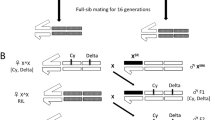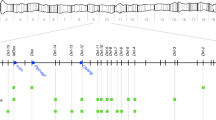Abstract
Sex-ratio (SR) meiotic drivers are X-linked selfish genetic elements that promote their own transmission by preventing the production of Y-bearing sperm, which usually lowers male fertility. The spread of SR drivers in populations is expected to trigger the evolution of unlinked drive suppressors, a theoretically predicted co-evolution that has been observed in nature. Once completely suppressed, the drivers are expected either to decline if they still affect the fitness of their carriers, or to evolve randomly and possibly get fixed if the suppressors eliminate their deleterious effects. To explore this issue, we used the Paris sex-ratio system of Drosophila simulans in which drive results from the joint effect of two elements on the X chromosome: a segmental duplication and a deficient allele of the HP1D2 gene. We set up six experimental populations starting with 2/3 of X chromosomes carrying both elements (XSR) in a fully suppressing background. We let them evolve independently during almost a hundred generations under strong sexual competition, a condition known to cause the rapid disappearance of unsuppressed Paris XSR in previous experimental populations. In our study, the fate of XSR chromosomes varied among populations, from extinction to their maintenance at a frequency close to the starting one. While the reasons for these variable outcomes are still to be explored, our results show that complete suppression can prevent the demise of an otherwise deleterious XSR chromosome, turning a genetic conflict into cooperation between unlinked loci. Observations in natural populations suggest a contrasting fate of the two elements: disappearance of the duplication and maintenance of deficient HP1D2 alleles.

Similar content being viewed by others
References
Angelard C, Montchamp-Moreau C, Joly D (2008) Female-driven mechanisms, ejaculate size and quality contribute to the lower fertility of sex-ratio distorter males in Drosophila simulans. BMC Evol Biol 8:326. https://doi.org/10.1186/1471-2148-8-326
Atlan A, Merçot H, Landre C, Montchamp-Moreau C (1997) The Sex-Ratio trait in Drosophila simulans: geographical distribution of distortion and resistance. Evolution 51(6):1886–1895. https://doi.org/10.1111/j.1558-5646.1997.tb05111.x
Atlan A, Joly D, Capillon C, Montchamp-Moreau C (2004) Sex-ratio distorter of Drosophila simulans reduces male productivity and sperm competition ability. J Evol Biol 17(4):744–751. https://doi.org/10.1111/j.1420-9101.2004.00737.x
Bastide H, Cazemajor M, Ogereau D, Derome N, Hospital F, Montchamp-Moreau C (2011) Rapid rise and fall of selfish sex-ratio X chromosomes in Drosophila simulans: spatiotemporal analysis of phenotypic and molecular data. Mol Biol Evol 28(9):2461–2470. https://doi.org/10.1093/molbev/msr074
Bastide H, Gérard PR, Ogereau D, Cazemajor M, Montchamp-Moreau C (2013) Local dynamics of a fast-evolving sex-ratio system in Drosophila simulans. Mol Ecol 22(21):5352–5367. https://doi.org/10.1111/mec.12492
Beckenbach AT (1996) Selection and the “sex-ratio” polymorphism in natural populations of Drosophila pseudoobscura. Evolution 50(2):787–794. https://doi.org/10.1111/j.1558-5646.1996.tb03888.x
Brown LD, Cai TT, DasGupta A (2001) Interval estimation for a binomial proportion. Stat Sci 16(2):101–133. https://doi.org/10.1214/ss/1009213286
Bull JJ, Charnov EL (1988) How fundamental are fisherian sex-ratios. Oxf Surv Evol Biol 5:96–13
Capillon C, Atlan A (1999) Evolution of driving X chromosomes and resistance factors in experimental populations of Drosophila simulans. Evolution 53(2):506–517. https://doi.org/10.1111/j.1558-5646.1999.tb03785.x
Carvalho AB, Klaczko LB (1993) Autosomal suppressors of sex-ratio in Drosophila mediopunctata. Heredity 71(5):546–551. https://doi.org/10.1038/hdy.1993.174
Carvalho AB, Vaz SC, Klaczko LB (1997) Polymorphism for Y-linked suppressors of sex-ratio in two natural populations of Drosophila mediopunctata. Genetics 146(3):891–902. https://doi.org/10.1093/genetics/146.3.891
Carvalho AB, Sampaio MC, Varandas FR, Klaczko LB (1998) An experimental demonstration of Fisher’s principle: evolution of sexual proportion by natural selection. Genetics 148(2):719–731. https://doi.org/10.1093/genetics/148.2.719
Carvalho AB, Vaz SC (1999) Are Drosophila SR drive chromosomes always balanced? Heredity 83(3):221–228. https://doi.org/10.1038/sj.hdy.6886100
Cazemajor M, Landré C, Montchamp-Moreau C (1997) The sex-ratio trait in Drosophila simulans: genetic analysis of distortion and suppression. Genetics 147(2):635–642. https://doi.org/10.1093/genetics/147.2.635
Clark AG (1987) Natural selection and Y-linked polymorphism. Genetics 115(3):569–577. https://doi.org/10.1093/genetics/115.3.569
Courret C, Gérard PR, Ogereau D, Falque M, Moreau L, Montchamp-Moreau C (2019) X-chromosome meiotic drive in Drosophila simulans: a QTL approach reveals the complex polygenic determinism of Paris drive suppression. Heredity 122(6):906–915. https://doi.org/10.1038/s41437-018-0163-1
Curtsinger JW, Feldman MW (1980) Experimental and theoretical analysis of the “sex-ratio” polymorphism in Drosophila pseudoobscura. Genetics 94(2):445–466. https://doi.org/10.1093/genetics/94.2.445
David J (1962) A new medium for rearing Drosophila in axenic conditions. Drosophila Information Service 36:128
Derome N, Baudry E, Ogereau D, Veuille M, Montchamp-Moreau C (2008) Selective sweeps in a 2-locus model for sex-ratio meiotic drive in Drosophila simulans. Mol Biol Evol 25(2):409–416. https://doi.org/10.1093/molbev/msm269
Dyer KA, Charlesworth B, Jaenike J (2007) Chromosome-wide linkage disequilibrium as a consequence of meiotic drive. Proceed National Acad Sci USA 104(5):1587–1592. https://doi.org/10.1073/pnas.0605578104
Dyer KA (2012) Local selection underlies the geographic distribution of sex-ratio drive in Drosophila neotestacea. Evolution 66(4):973–984. https://doi.org/10.1111/j.1558-5646.2011.01497.x
Fisher RA (1930) The Genetical Theory of Natural Selection. Claredon Press, Oxford
Fouvry L, Ogereau D, Berger A, Gavory F, Montchamp-Moreau C (2011) Sequence Analysis of the Segmental Duplication Responsible for Paris Sex-Ratio Drive in Drosophila simulans. G3 Genes Genomes Genetics 1(5):401–410. https://doi.org/10.1534/g3.111.000315
Haldane JBS, Jayakar SD (1964) Equilibria under natural selection at a sex-linked locus. J Genet 59(1):29–36
Hall DW (2004) Meiotic drive and sex chromosome cycling. Evolution 58(5):925–931. https://doi.org/10.1111/j.0014-3820.2004.tb00426.x
Hamilton WD (1967) Extraordinary sex ratios. Science 156(3774):477–488. https://doi.org/10.1126/science.156.3774.477
Hauschteck-Jungen E, Maurer B (1976) Sperm dysfunction in sex ratio males of Drosophila subobscura. Genetica 46:459–477. https://doi.org/10.1007/BF00128092
Helleu Q, Gérard PR, Montchamp-Moreau C (2015) Sex chromosome drive. Cold Spring Harb Perspect Biol 7(2):a017616. https://doi.org/10.1101/cshperspect.a017616
Helleu Q, Gérard PR, Dubruille R, Ogereau D, Prud’homme B, Loppin B, Montchamp-Moreau C (2016) Rapid evolution of a Y-chromosome heterochromatin protein underlies sex chromosome meiotic drive. Proceed Natl Acad Sci USA 113(15):4110–4115. https://doi.org/10.1073/pnas.1519332113
Helleu Q, Courret C, Ogereau D, Burnham KL, Chaminade N, Chakir M, Aulard S, Montchamp-Moreau C (2019) Sex-Ratio meiotic drive shapes the evolution of the Y chromosome in Drosophila simulans. Mol Biol Evol 36(12):2668–2681. https://doi.org/10.1093/molbev/msz160
Jaenike J (1999) Suppression of sex-ratio meiotic drive and the maintenance of Y-chromosome polymorphism in Drosophila. Evolution 53(1):164–174. https://doi.org/10.1111/j.1558-5646.1999.tb05342.x
Jaenike J (2001) Sex chromosome meiotic drive. Annu Rev Ecol Syst 32:25–49. https://doi.org/10.1146/annurev.ecolsys.32.081501.113958
James AC, Jaenike J (1990) “Sex ratio” meiotic drive in Drosophila testacea. Genetics 126(3):651–656. https://doi.org/10.1093/genetics/126.3.651
Keais GL, Lu S, Perlman SJ (2020) Autosomal suppression and fitness costs of an old driving X chromosome in Drosophila testacea. J Evol Biol 33(5):619–628. https://doi.org/10.1111/jeb.13596
Kearse M, Moir R, Wilson A, Stones-Havas S, Cheung M, Sturrock S, Buxton S, Cooper A, Markowitz S, Duran C, Thierer T, Ashton B, Meintjes P, Drummond A (2012) Geneious Basic: an integrated and extendable desktop software platform for the organization and analysis of sequence data. Bioinformatics 28(12):1647–1649. https://doi.org/10.1093/bioinformatics/bts199
Kingan SB, Garrigan D, Hartl DL (2010) Recurrent selection on the Winters sex-ratio genes in Drosophila simulans. Genetics 184(1):253. https://doi.org/10.1534/genetics.109.109587
Montchamp-Moreau C, Joly D (1997) Abnormal spermiogenesis is associated with the X-linked sex-ratio trait in Drosophila simulans. Heredity 79:24–30. https://doi.org/10.1038/hdy.1997.119
Montchamp-Moreau C, Ginhoux V, Atlan A (2001) The Y chromosomes of Drosophila simulans are highly polymorphic for their ability to suppress sex-ratio drive. Evolution 55(4):728–737. https://doi.org/10.1111/j.0014-3820.2001.tb00809.x
Montchamp-Moreau C, Cazemajor M (2002) Sex-ratio drive in Drosophila simulans: variation in segregation ratio of X chromosomes from a natural population. Genetics 162(3):1221–1231. https://doi.org/10.1093/genetics/162.3.1221
Pinzone CA, Dyer KA (2013) Association of polyandry and sex-ratio drive prevalence in natural populations of Drosophila neotestacea. Proc R Soc B 280(1769):20131397. https://doi.org/10.1098/rspb.2013.1397
Policansky D, Ellison J (1970) “Sex ratio” in Drosophila pseudoobscura: spermiogenic failure. Science 169(3948):888–889. https://doi.org/10.1126/science.169.3948.888
Presgraves D (2008) Drive and sperm: the evolution and genetics of male meiotic drive. In: Birkhead TR, Hosken D, Pitnick S (eds) Sperm biology: an evolutionary perspective. Academic Press, London, pp 471–506
Presgraves DC, Severance E, Wilkinson GS (1997) Sex chromosome meiotic drive in stalk-eyed flies. Genetics 147(3):1169–1180. https://doi.org/10.1093/genetics/147.3.1169
Price TAR, Bretman AJ, Avent TD, Snook RR, Hurst GDD, Wedell N (2008) Sex ratio distorter reduces sperm competitive ability in an insect. Evolution 62(7):1644–1652. https://doi.org/10.1111/j.1558-5646.2008.00386.x
Price TAR, Hodgson DJ, Lewis Z, Hurst GDD, Wedell N (2008) Selfish genetic elements promote polyandry in a fly. Science 322(5905):1241–1243. https://doi.org/10.1126/science.1163766
Price TAR, Hurst GDD, Wedell N (2010) Polyandry prevents extinction. Curr Biol 20(5):471–475. https://doi.org/10.1016/j.cub.2010.01.050
Price TAR, Lewis Z, Smith DT, Hurst GDD, Wedell N (2010) Sex ratio drive promotes sexual conflict and sexual coevolution in the fly Drosophila pseudoobscura. Evolution 64(5):1504–1509. https://doi.org/10.1111/j.1558-5646.2009.00896.x
Price TAR, Windbichler N, Unckless RL, Sutter A, Runge JN, Ross PA, Pomiankowski A, Nuckolls NL, Montchamp-Moreau C, Mideo N, Martin OY, Manser A, Legros M, Larracuente AM, Holman L, Godwin J, Gemmell N, Courret C, Buchman A, Barrett LG, Lindholm AK (2020) Resistance to natural and synthetic gene drive systems. J Evol Biol 33(10):1345–1360. https://doi.org/10.1111/jeb.13693
Stalker HD (1961) The genetic systems modifying meiotic drive in Drosophila paramelanica. Genetics 46(2):177–202. https://doi.org/10.1093/genetics/46.2.177
Tao Y, Araripe L, Kingan SB, Ke Y, Xiao H, Hartl DL (2007) A sex-ratio meiotic drive system in Drosophila simulans II: an X-linked distorter. Publ Lib Sci Biol 5:e293. https://doi.org/10.1371/journal.pbio.0050293
Tao Y, Masly JP, Araripe L, Ke Y, Hartl DL (2007) A sex-ratio meiotic drive system in Drosophila simulans I: an autosomal suppressor. Publ Lib Sci Biol 5:e292. https://doi.org/10.1371/journal.pbio.0050292
Thomson GJ, Feldman MW (1975) Population genetics of modifiers of meiotic drive: IV On the evolution of sex-ratio distortion. Theor Pop Biol 8(2):202–211
Vaz SC, Carvalho AB (2004) Evolution of autosomal suppression of the Sex-Ratio trait in Drosophila. Genetics 166(1):265–277. https://doi.org/10.1534/genetics.166.1.265
Voelker RA (1972) Preliminary characterization of “sex ratio” and rediscovery and reinterpretation of “male sex ratio” in Drosophila affinis. Genetics 71(4):597–606. https://doi.org/10.1093/genetics/71.4.597
Wedell N (2013) The dynamic relationship between polyandry and selfish genetic elements. Philos Trans R Soc B 368(1613):20120049. https://doi.org/10.1098/rstb.2012.0049
Wilkinson GS, Presgraves DC, Crymes L (1998) Male eye span in stalk-eyed flies indicates genetic quality by meiotic drive suppression. Nature 391:276–279. https://doi.org/10.1038/34640
Wilkinson GS, Johns PM, Kelleher ES, Muscedere ML, Lorsong A (2006) Fitness effects of X chromosome drive in the stalk-eyed fly, Cyrtodiopsis dalmanni J Evol Biol 19(6):1851–1860. https://doi.org/10.1111/j.1420-9101.2006.01169.x
Wu CI (1983) The fate of autosomal modifiers of the sex-ratio trait in Drosophila and other sex-linked meiotic drive systems. Theor Popul Biol 24(2):107–120. https://doi.org/10.1016/0040-5809(83)90035-7
Wu CI (1983) Virility deficiency and the sex-ratio trait in Drosophila pseudoobscura I Sperm Displacement and Sexual Selection. Genetics 105(3):651–662. https://doi.org/10.1093/genetics/105.3.651
Acknowledgements
We thank Kevin Poissenot, Fanny Husson for technical assistance, as well as Sylvie Nortier for medium preparation. Several lines used in this study were derived from flies collected by Jean R. David and Daniel Lachaise. We also thank Quentin Helleu and two anonymous reviewers for very helpful discussions.
Funding
This work was funded by Centre National de la Recherche Scientifique and Université Paris-Saclay. HB was funded by a French ministry scholarship.
Author information
Authors and Affiliations
Contributions
H.B. conceived and designed the research; H.B., P.R.G., and D.O. performed research; P.R.G., H.B., and C.M.M. analyzed the data and wrote the paper.
Corresponding authors
Additional information
Responsible Editors: Stacey Hanlon and Amanda Larracuente.
Publisher's note
Springer Nature remains neutral with regard to jurisdictional claims in published maps and institutional affiliations.
Supplementary Information
Below is the link to the electronic supplementary material.
Rights and permissions
About this article
Cite this article
Bastide, H., Ogereau, D., Montchamp-Moreau, C. et al. The fate of a suppressed X-linked meiotic driver: experimental evolution in Drosophila simulans. Chromosome Res 30, 141–150 (2022). https://doi.org/10.1007/s10577-022-09698-1
Received:
Revised:
Accepted:
Published:
Issue Date:
DOI: https://doi.org/10.1007/s10577-022-09698-1




